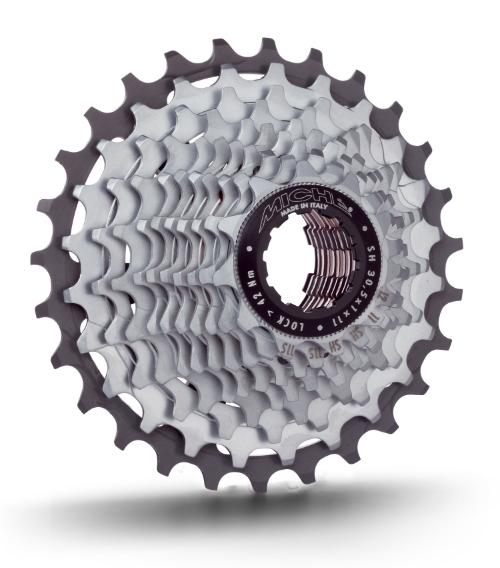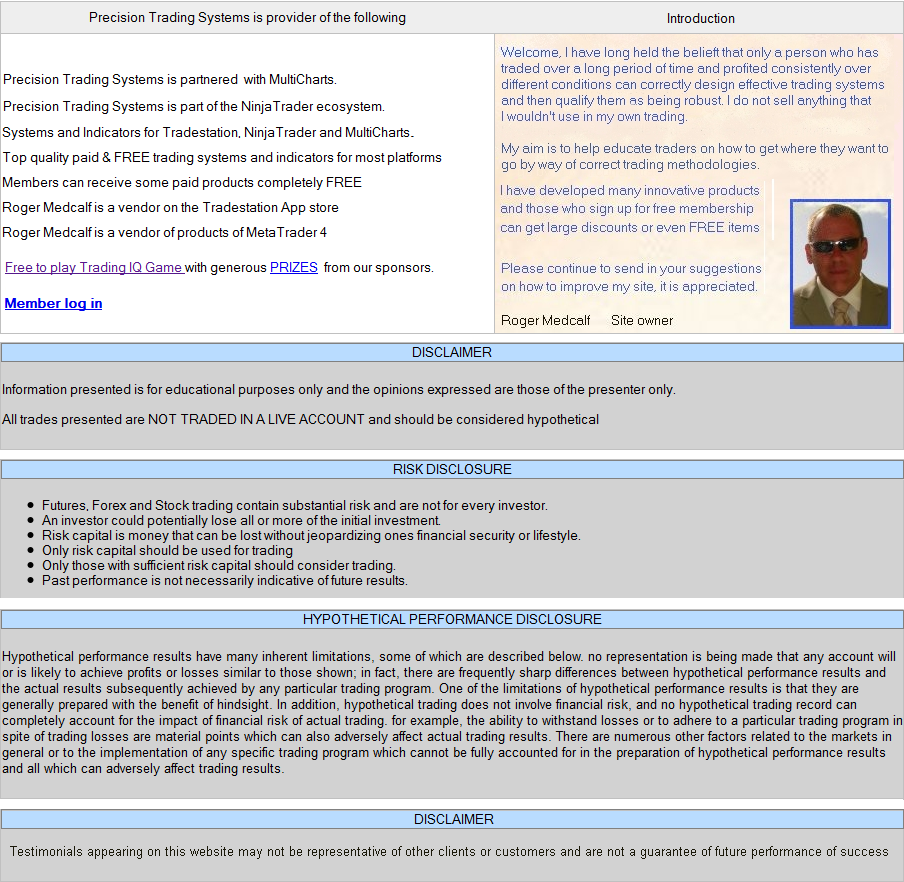
|
|
PRECISION PROBABILITY INDEX WITH E-MINI SP500 FUTURES ( ES )
<< QUESTION >>
Hello Roger,
Thanks for sending me this information about your new product. I reviewed the contents and watched the video. It's seems very impressive and I would like to ask you a few questions.
First, I'm assuming the strategy must be run 24 hours a day and even thru the weekends, is that correct? If so, if I'm trading the E-mini Nasdaq, can that be done with an initial account size of about $5,000? I know my broker requires that I close all trades at 1pm PST, and than I can open them again after 15 minutes. The only way I can leave the position open during those 15 minutes is if I have much more money in the account (I'm not sure exactly how much). It's kind of a ridiculous rule if you ask me, but I guess it has something to do with the exchanges margin requirements for holding positions past the day session.
Second, speaking of my initial $5,000 account size, is that something that you would even recommend? I wish I could afford more, but that's all I have right now. I feel confident in strategy of yours, but you know better than I if that's wise or not. Perhaps if I traded only one contract and I get lucky in the first month, my account size could build up to a point where I would be in a safer position. What do you think?
Finally, would you be able to recommend some settings for me to use with the NQ? Your strategy sure has a lot of flexibility, which I think is great, but for an amateur like myself it can also be rather confusing. I guess I could experiment myself and back test different settings, but I thought maybe your greater experience and knowledge would save me some losses.
In advance, thank you for your time. I hope you've recovered now from your cold. I caught a bad one myself this past few days.
Respectfully,
<< ANSWER >>
I am glad you asked me first so I can disuade you from doing this.
I am not regulated I am not allowed to suggest parameters. This must be your decision based on your testing.
The E-mini SP500 contract is $50 per point, a model set up to run with a sensible average losing trade of 10 points = $500 loss per losing trade, a ( perfectly normal and expected ) string of 10 losses in a row = a bust account. Probably just 5 losers in a row = a margin call.
The video shown here http://www.precisiontradingsystems.com/Precision_Probability_Index_NinjaTrader.html
States at the top
TRADING IN THE 20 TICK TIME FRAME SHOWN IN THE VIDEO IS NOT RECOMMENDED DUE TO COMMISSION COSTS
This video is for the purpose of showing the mechanics of the strategy and is not designed to run at such a busy frequency as it would be a net loser when adding $3.80 to $5 per round turn onto the costs.
Starting with a small account is something most of us have done and hoping to get lucky is something most of us have done too. However this hope needs to backed up by some sensible risk control and expectations.
A good starting point is to think backwards.
1. Risk per trade = 1% as maximum loss from entry price to stop.
2. This would be $5000 x 0.01 = $50 ( If the account grows to $7000 then you can risk $70 per trade and risk $40 if $4000 )
3. What markets can be traded CORRECTLY with a $50 risk per trade?
4. This counts out all futures contracts
5. What is left? Stocks traded in small sizes and held overnight without being forced to close at 1pm
6. For example Apple stock is $93 per share and a reasonable loss per trade might be 10 points If buying at $93 and getting stopped or reversing at $83 so you can compute $50 risk on 10 points = 5 shares of Apple stock.
7. There are many such stocks trading at $80 a share or less and some would be highly profitable using the Precision Probability Index on autotrading with sensible settings which might trade once or twice in a week.
8. Can you sleep at night using this model?
If you asked me I would say yes to a $80 stock with 5 shares and no to SP500 futures with a $5000 account.
9. You can then proceed to test a whole bunch of stocks and settings and pick a group of 5 or 10 that have performed well on recent data and trade them all at once on an automated basis.
10. The overal risk combined of all the 1% risk per trade ( $50's ) added must be a sensible figure and exceeding 10% is a bit dangerous
If you accept and execute these points then you have a good chance to keep most of your $5000 and perhaps grow it up to the $50,000 you would need to trade the E-mini ES in a businesslike and correct manner.
I hope this helps
Image of gear cluster. Knowing which cog to engage, depends on where you are cycling.


|
|
Roger,
Thank you for your reply. I kind of suspected you were going to say that.... I guess I was looking for someone to sign off on this crazy idea of mine. :-)
In regards to your idea about using the strategy on stocks, I was wondering, wouldn't it be better if I traded lower price stocks (like in the $20 to $30 range)? This way I could trade more of them, and thereby increase my profit without taking on more risk.
Also, would it really be more profitable or safer to trade five or ten stocks, as opposed to just sticking with one stock? It seems to me like your strategy makes money when a market is trending and losses money when it's consolidating (which is actually a very common theme among all the strategies I've run across). As such, how would trading more than one stock change that dynamic?
Once again, thanks for your great input and wisdom.

|
|
Yes absolutely. That was what I meant in point No.9 above
Having diversification is another good and logical way to reduce market risk and think backwards. ( In terms of how much can I lose on a bad week, rather than thinking how much can I made on a good week )
A few points to consider that support your idea.
1. Elephants don't run ( Microsoft or Apple or Google are unlikely to double or halve in month, but many small stocks can do that )
2. You might run into difficulty finding a broker to autotrade the tiny stocks which move in more favourable trends than larger stocks.
3. Using a sub-account one for each stock and isolating its funds allows the 1% risk allocation to grow or shrink in a more logical manner.
EG If you buy a small stock that quadruples when you are long and halves when you are short, this account would be about 5-6 times bigger than some of the others and thus 1% risk allocation unit of that sub account would be proportionately larger than the other sub accounts ( This rewards the best strategy + stock combination with more money and means poor performers get less money ) a very logical method which will increase overall profitability at the expense of having more violent fluctuations on the account.
Instead if the accounts are "tied" this best performer would only get a small amount more money to trade and the poor performers would also get the same uplift in trade size even though they did not "earn" it.
4. Choosing markets that are not highly correlated is a good thing to do as some will be long and some will be short and this reduces "market risk" in the sense that if you walk into a 1987 crash type event you would lose much less ( or even profit ) if some of your portfolio are down-trending stocks with short positions.
5. The students of diversification seem to think 12 is "enough" positions to have a good diverse risk. My argument is why not have more than 12 different positions, frequently I have more than 40 trades running at once and the losers do not give me any headaches as there are always plenty of big winners to compensate me for those.
6. For further diversification you can also consider trading ETF's of commodities which are not stock based, and those that are long only often have a short ETF or "Ultra short ETF" which can be bought and move up if the underlying market falls.
7. Spreading the trades over many different sectors is a good way to reduce market risk and improve your chances to get on board a big trend.
